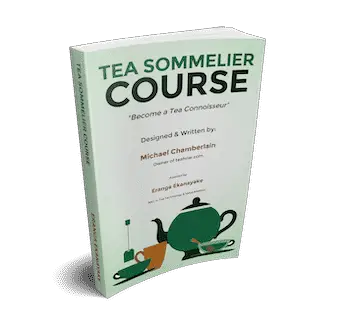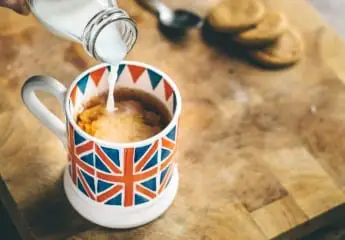The most popular tea in England? Well, the UK consumes a large amount of Tea! But believe it or not, Turkey consumes the most, followed by the likes of Morocco, and then it’s Ireland next, followed closely by England.
So what is the most popular Tea in England?
Black Tea is by far the most purchased and consumed type of tea in England and the UK. It’s the one that fills the supermarket shelves and, is a commonly offered beverage in any home you might visit. The popularity of black tea is followed by Earl Grey, Oolong, and Herbal teas.
Let’s look in more detail at the popularity of Teas in the UK. Because it differs quite a bit from how popular tea is in the USA. And in that article, I’ve got all kinds of stats related to that.
And if you’re wondering what on earth tea is, then read my article about What Is Tea.
To other nations, the typical tea in England would probably be referred to as ‘Breakfast Tea’ as it’s taken mostly with milk and when a sweeter taste is preferred then Brits typically add one or two teaspoons of sugar (or artificial sweeteners for the Calorie Conscious).
The sweetener is applied partly to negate some of the bitterness from the speed and strength of steeping and partly due to how Tea has historically been served.
I have to add that if you’ve ever had a ‘Full English Breakfast’ in the UK, then having breakfast tea alongside it is a must. For me, the two are perfect together and I’d highly recommend it. Just make sure you put the calorie counter to one side!
Here I provide a guide on the most popular ‘league table’ of teas consumed in the UK (so not just England).
Most Popular Type of Tea in England 2021
1. Black Tea
Black Tea, of course, tops the list, mostly taken with milk, mostly in teabag form. The faster steeping process due to the finer tea particles tends to yield a faster, stronger, and punchier taste. Largely with types such as Kenyan and Assam being the most popular.
This is in some contrast to the slower steeped fragranced pot of the more delicate blends.
The use of the Tea Bag has been fuelled by the convenience factor in today’s fast pace society. Because it’s quicker to make than loose-leaf teas. Even though looseleaf provides a more flavourful experience. Brits would typically make a pot of loose-leaf tea for a more relaxing occasion drink than a midday beverage.
The tea bag is however under threat, the move towards removing Plastic from Tea bags has prompted many to seek tea bags made from more organic materials – or simply to switch to loose tea. As with most things organic, this does increase the cost of production, which will undoubtedly be passed onto the consumer.
We move on to the next most popular, but here’s where the numbers get a little ‘guesswork’!
2. Earl Grey
The name given to Earl Grey was believed to be after a gift of tea from China that was presented to the then UK Prime Minister Charles Grey in 1830.
Earl Grey was traditionally always a Black Tea, however, as there are now over 1500 varieties of tea in general, Earl Grey has seen its fair share of flavor varieties appearing. These include variations stemming from other tea types such as Oolong Tea or Green Tea.
Earl Grey – in the UK at least, is served without milk and steeped for longer. Providing more health benefits, infused with Citrus Oil known as Bergamot, taken from the variety of fruit called the bergamot orange which is a hybrid fruit.
Here are the differences between Earl Grey and Black tea.
Next most popular…
3. Green Tea
The Health boom is responsible for the recent steeper demand for Green Tea. Suddenly Tea was ‘cool’ again as it has been proven to have numerous health benefits. This is particularly true of Green Tea which is now pushed as a healthier ’alternative’ to Black Tea.
Other than White Tea, Green tea – which yes is actually light green in color! Undergoes less oxidization and manufacturing processes, thus retaining more of its natural mineral properties.
Its less bitter and refreshing taste is very palatable without the need for sweetening. Its natural plant aroma even makes you feel natural and healthy whilst drinking it. The tastes and fragrances can vary largely depending on how much processing and oxidation it has undergone.
4. Herbal Teas
The new kids on the block! Recent times have seen the growth of Herbal and Speciality Teas, that – if we’re being official about it, are not actually Teas at all, as they don’t all stem from the Camellia Sinensis Plant. But are made from other more herbal-based plant and fruit extracts and other ingredients like roses!
Nonetheless, they’ve become part of the family and are a spin-off of the health benefits of Green Tea. Rose Tea anyone?
5. Oolong
A semi-fermented Chinese tea (they call it ‘Black Dragon Tea’). Most often taken loose. Usually appears in a curled or rolled ball shape. Tastes can vary from woody, thick and smokey right through to fruity and sweet with bags of fragrance. It’s expensive Tea and therefore mostly drank occasionally.
The process is heavy but largely natural. The Oolong is Sundried through the ‘Withering’ process longer than most other teas and undergoes a repeating manufacturing process.
6. Others
I’ve just added this, to caveat that there are many types and varieties of Tea stemming from the main tea types. This is by no means a definitive list. But I do think it accurately reflects tea tastes in England and the UK.
How Many Cups of Tea a Day Do the British Drink?
Let’s not get carried away, in Britain and the UK, Coffee outranks Tea as the most consumed beverage. Each day, a person on average drinks 2.5 cups of coffee to every 1 cup of tea. So Coffee has a clear lead. But Tea does have a special place in the hearts of every Brit … well, most of them! See more on how many cups of tea you should drink per day.
UK Tea Consumption Statistics
The graph below shows the growth of tea consumption in the UK, according to Statista.com

Brits drink an average of around 2-3 cups per day. Nationally that equates to 165 million cups every day in the UK – adding up to 60.2 Billion Cups a year. Tea is still big business in the UK and growing!
Why is Tea So Popular in the UK?
Tea is popular in the UK mainly due to historic cultural growth, for which we mostly have the Duchess of Bedford to thank for creating the idea of Afternoon Tea. Queen Victoria getting in on the act also contributed to boosting the popularity of Tea enormously during the mid to late 19th Century. The idea of Afternoon Tea became aspirational to the working class and soon all of the UK was drinking Tea!
Despite a minor dip during WWI and WWII – mainly due to rationing, the scale soon picked up during peacetime as it continued to be the staple beverage (after water) throughout the United Kingdom.
Tea consumption saw a decline during the proliferation of coffee shops in the late Nineties and up to the present, Initially, Tea plummeted in popularity. However, it has since seen an increase in recent years.
Tea Revival Was Fuelled by Two Factors.
Firstly, the Vintage Era revival that took place in the early part of the 21st Century. Followed by the introduction of the Speciality and Health driven Tea boom, where tea of all varieties and tastes began to spring up.
On a more macro scale, Tea has seen a steady increase in consumption during the first 15 years of the 21st century.
This is reflected in the growth in the global production of Tea. This increase in demand has seen it now being grown in over 50 countries and consumed in over 160 around the world.
See the chart below based on a report concerning Growth in Tea Production from 2001 to 2015. The rise is expected to continue by 4% up to 2021.

This should help answer questions like what is the most popular type of tea in England, ‘is Tea Coffee in England’ – yes really people do ask that question. But most of all we hope it’s provided you with an insight into the Popularity of Tea in the UK.
Interested in taking your tea skills to the next level? Then consider my fast-track Tea Sommelier Course.

Take the fast track and become a tea connoisseur
Whether for enjoyment or considering a career as a tea sommelier. This course has everything you need to enhance your tea knowledge and tea-tasting skills.
This course keeps it simple with step-by-step tea tasting and easy reference guides
For pleasure, or as a precursor to a career in the tea industry. Find out what tea sommelier actually does, their career paths, and what they earn.

Find out more about the Teahow Tea Sommelier Course!

I am a History teacher in Mexico, I need information about the tea drunk on the American Revolution( 1776), Thank you very much, greetings from Jalisco
[…] to an article by Tea How, the English prefer to drink black tea. Now, that’s not tea without milk, but the type of tea. […]